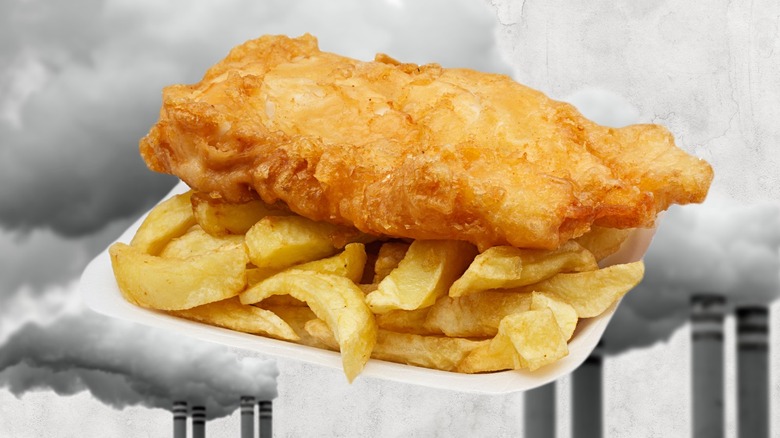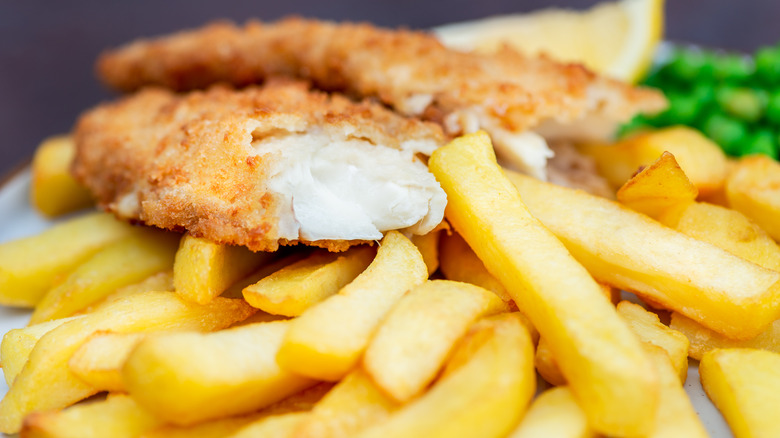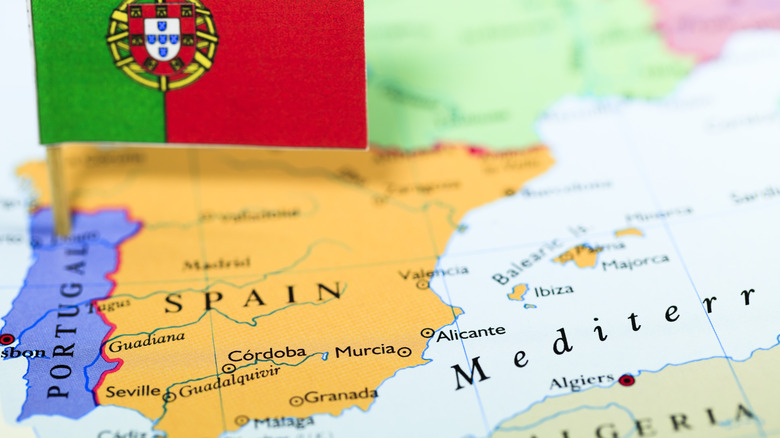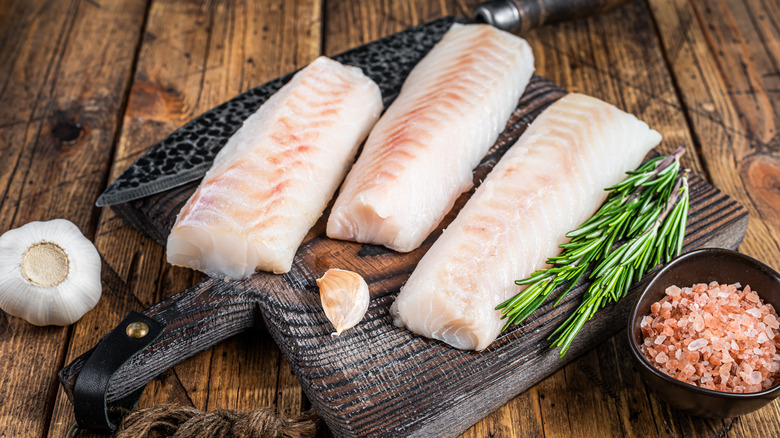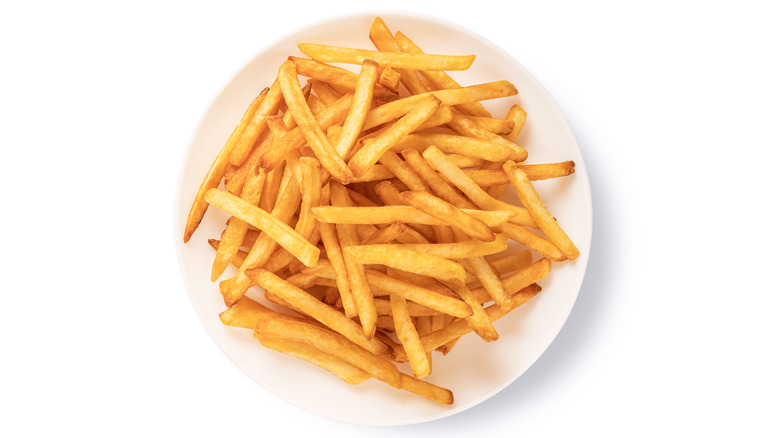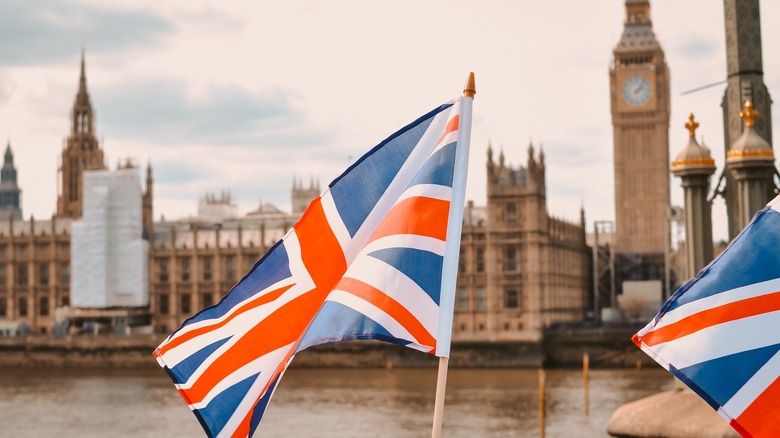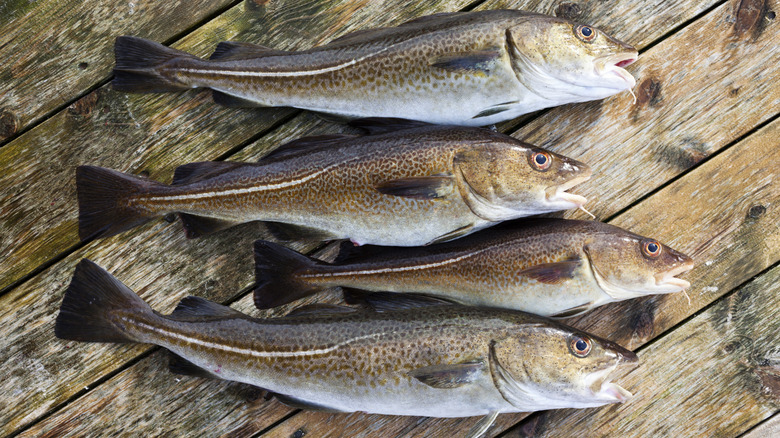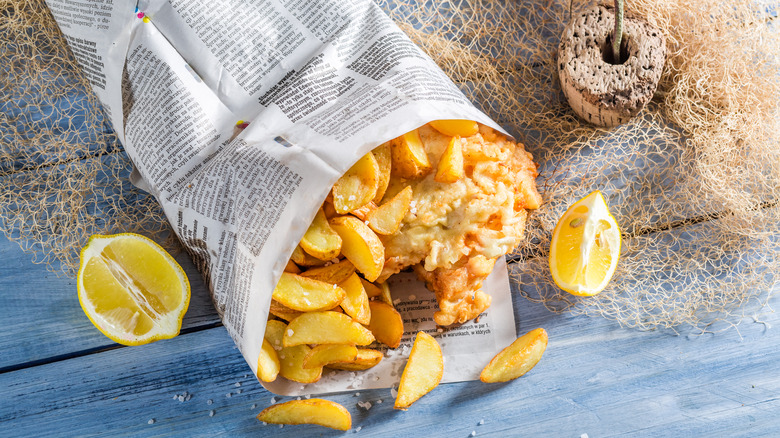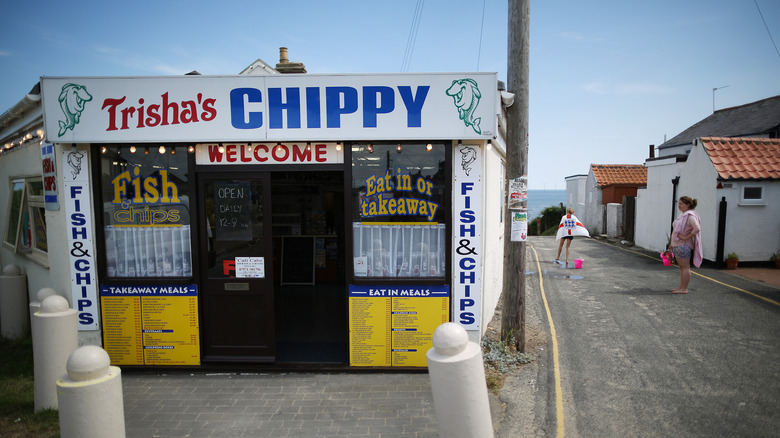The Contentious Industrial Origins Of Fish And Chips
For those unfamiliar with the dish, fish and chips is a battered, deep-fried piece of flaky white fish served with crispy fries around the globe. This salty and satisfying meal has gained tons of fans, especially in the United Kingdom and America. You'll likely see the fare on most bar menus, seemingly never going out of season. However, the much-loved dish has a long and complicated history. From the dish's name to its origin story, fish and chips is a dish that inspires heated debate.
One thing's for sure, there's a deep appreciation for fish and chips. In the United Kingdom, there are over 10,000 fish and chip shops. The British consume approximately 382 million meals of fish and chips every year and spend about 1.2 billion euros on the industry. In America, the dish appears on seafood restaurants' menus and as a traditional and hearty bar food option. Sports bars and grills, breweries, and even the occasional Italian restaurants frequently have this fried meal on the menu. Despite the world's consensus that fish and chips should always be on the menu, the dish's origin cause some controversy. Looking back throughout the years and across the globe, here is the truth about the contentious industrial history behind fish and chips.
Traditional Fish and Chips
What exactly defines fish and chips? Recently, chefs and cooks have gotten creative with their interpretations of the classic meal. Various species of fish have been utilized in the dish. The batter is not always the same — especially with gluten-free recipes and the rising popularity of air fryers. Typical french fries have been swapped out for sweet potato fries or potato chips. However, this classic dish has two essential components that consistently make up the hearty meal perfect on a rainy London day or on a hot summer evening in the U.S. Cooks deep-fry a filet of cod or haddock in a simple batter and pair it with a crispy side-dish. Often, the meal is served on wrapped paper and has a side of lemon and tartar sauce, too.
Fish and chips is a filling and somewhat greasy meal — but that's what the paper is for! The batter pairs perfectly with white, flaky fish that will melt in your mouth. The fries are an inexpensive but tasty side order. A pinch of salt over the fries, a splash of malt vinegar, or a squeeze of lemon also became popular ways to serve the meal. This brilliant meal is often enjoyed at lunchtime with a cool drink or an easy dinner for the whole family. Over 50 percent of British consumers buy fish and chips for a simple family meal to be enjoyed at home.
Here's the origin of fish and chips
Less than 200 years ago it would've been next to impossible to find this popular food pairing in Britain. The combination of fried fish and potatoes didn't begin in the United Kingdom. The dish originated in Portugal when Judaism was prominent and influential. Prior to today's modern technology of refrigerators and microwaves, many aspects of culinary invention were born out of necessity rather than a luxury: That was the case with fish and chips.
Frying cod and haddock in a flour batter was originally an excellent way to preserve the freshness of fish, which was necessary for Jewish people who practiced the Sabbath. The Sabbath lasts from sundown on Friday until sunset on Saturday. During this time, cooking is prohibited. This tradition is in recognition of their belief that God created the world in six days and rested on the seventh. As food can not be prepared during Sabbath, it became common for people to prepare fried fish earlier in the week and then enjoy it on the seventh day of rest.
Preparing fish this way preserved the salty and satisfying flavor of the fish. This practice was eventually brought to Britain when the Spanish invaded Portugal, as many Jewish immigrants fled after their religion became outlawed. Soon immigrants began selling the easy meal to their British neighbors and frying fish became known as the Jewish way of preserving fish.
The fish
There isn't just one type of fish to choose from to cook fish and chips. There are three popular fish frequently used for the dish. Of course, the most common fish is cod, which is followed by haddock and pollock. As battered fish's popularity grew later in England, the demand for cod greatly influenced the fishing industry in many countries.
Cod is often used for fish and chips because of its pleasant and mild flavor. The fish flavor is not overpowering and the slightly sweet taste goes well with salty potatoes and seasoned batter. Most fish and chip recipes call for this type of fish because the tender meat becomes flaky when cooked. Cod was already the go-to option for mild fish before industrial fishing took over. With modern technology, catching and preserving fish became easier — leaving the species seriously depleted. Governments in several countries put strict regulations in place to replenish the fish population. Today, pollock and haddock are used in place of cod. Some chefs prefer haddock for fish and chips because the meat is sweeter than cod — though it's not as flaky or tender.
Using pollock in fish and chips was a controversial choice. It's not a fish revered as a tender and flaky option. However, pollock keep its shape as well and is a great nutritional alternative.
The chips
There's hardly anything more satisfying than a crunchy french fry, so it's no surprise that they can be found in various cuisines globally — from loaded taco fries to breakfast casseroles. Yet, where did the salty snack originate? How did it end up being served with fried fish? Fried potatoes may have French in the title, but really they can be traced back to a French-speaking Belgium city named Namur. The city was quite fond of fried fish. There are rumors that one year when the river froze people took to frying up potatoes instead. However, fat for frying was not easy to come by during this time, so the rumor has been debated. It's difficult to say where french fries originated, but it is undeniable that they are a staple ingredient in today's world.
Potatoes did not make their way to England until the mid-1500s. From then on, frying potatoes was not frequently mentioned until Charles Dickens wrote about them in "A Tale of Two Cities." In that instance, fried potatoes were mentioned alongside fried fish in a meal. Shortly after, the first restaurant dedicated to fish and chips set up shop, and there's been no looking back! Today, french fries are served in all shapes and sizes. From long and thin to flat and wide, they remain an affordable favorite. Malt vinegar, salt, and tartar sauce all give fries some extra tang.
The British History
Prior to the fish and chip shops found throughout England, the dish could be bought in a much more casual fashion. When Jewish immigrants fled religious persecution in Portugal, they came to England and frequently sold fish and chips wrapped in paper along the streets. Sellers would attach a tray to a leather strap and hang them around their necks to hold several servings at once. The fish and chips would be warped in paper or newspaper to soak up the grease, making it an easy on-the-go meal for everyone to enjoy.
The dish could be bought at any time of the day and was the perfect remedy for cold weather or after a long day of work. Soon enough, the meal became so prevalent that most came to believe that fish and chips originated in or near London. Eating fish and chips is now considered a quintessentially British experience. As mentioned more than once by Charles Dickens in his work, fish and chips inadvertently became a British tradition and staple meal.
Then came the steam-powered trawler
The concept of the steam-powered engine arrived in the early 18th century and was improved upon as the desire for faster travel and more efficient expansion became important. Love for fish and chips fueled the steam-powered trawler. The industrial invention made supplying fresh fish much easier and it gave the fishing industry a major boost.
Cod and haddock are considered groundfish, which means they live and feed near the bottom of the ocean — rather than swimming freely through the depths. For this reason, some think that catching cod would be difficult. However, fishermen made quick use of trawling nets. These wide nets dragged along the seabed, where they easily scooped up large amounts of the white flaky fish. This effective method was only made even more efficient with the invention of the steam-powered trawler. The faster boats and fishing methods nearly put sailboats and schooners out of service because they were so much slower. However, this method of fishing was cause for concern right from the beginning.
Fishermen and scientists predicted that the groundfish supply would run out with this advanced tactic. By 1930, the groundfish supply was so low that Harvard University began studying how many groundfish were being caught each year. Restrictions on fishing were put into place, but it was too little and too late. It took years to bring fish species back from the brink of extinction.
Steam-powered locomotives made distribution easy
Around the time that traveling and fishing by boat was becoming faster and more efficient, ground transportation also improved too. The layout and need for an expansive method of travel were needed when the Industrial Revolution arrived, so it was only a matter of time before the railroad took over. In the early 1800s, the capabilities of railroads were just becoming known. Suddenly, there was a way to transport extremely heavy materials and people in a fast and efficient way.
The introduction of the railroad had a ripple effect on many industries across Britain and North America. It made expansion infinitely more possible, as a train could easily transport building materials, machines, and lots of people to faraway destinations. Quickly getting from one place to another was in high demand and more and more money became funneled into the railroad. This fast and easy method of travel was big news for the fishing industry. Fresh fish could be transported quickly to cities further from the coast. The demand for all kinds of fish — including the now favored cod and haddock — only continued to rise. But whenever a hiccup occurred during the railroad's expansion, a solution was around the corner. Wood rails were made into cast iron, then wrought iron, and finally, the nearly indestructible steel was introduced. The fishing industry rejoiced at the new technology, and the railroad's ability to sell more products.
The first-ever fish and chip shop
Near the end of the Industrial Revolution, fish and chips were already a well-established favorite, but then came the first-ever fish and chip shop. The shop was opened in 1860 by a Jewish immigrant named Joseph Malin. The Eastern European named the shop Malin. Customers came to recognize the shop for its blue and white tiles and bold black sign displayed over the front door. Over the years, the shop changed hands but continues to serve the fan-favorite dish.
In the mid-1960s, the shop gained more attention as researchers tried to track down the origins of the first-ever fish and chip shop. A few years later, the National Federation of Fish Friers presented Malin's shop with a plaque awarding it as the world's oldest fish and chip business. However, there's more controversy to unpack! Some believe that another has earned the title of the oldest shop. John Lees supposedly started selling fish and chips from a small setup in Northern England a few years before Malin did. This establishment served fish and chips up until the 1970s. However, it's well-proven that the concept of the fish and chip shops started around 1860 and continued to grow in popularity across England and elsewhere.
Fish and Chips during World War I & II
The meal's history winds through English records and still remains a favorite among the masses today. Fish and chips had been so connected to British people over the years that the dish even played a minor role in both World Wars.Before the First World War shook the globe and recruited men to the cause, most streets with a fish and chip shop on the corner were busy on any given afternoon. They were often bustling with men on their way home from work, kids, and those who wanted a tasty affordable meal. This was such a common practice that during the war, Prime Minister David Lloyd George, kept fish off of the ration list — meaning fish and chips shops could remain open. This move was intended to boost the morale of those still in the cities.
When World War II came, Winston Churchill and the government worked to protect the family favorite. A hot meal that was adored by the British people became a symbol of normalcy and it was kept from the list of rationed food. Although that didn't mean that fresh fish was still easy to harvest. As the war waged on, the cost of fish rose. The fishing trawlers that were once designated for groundfishing were employed by the government and repurposed for battle and other types of war aid — making a plate of fish and chips a rarer treat.
The Modern Chippy
Fish and chips underwent a long journey before it earned its place on most bar menus. The first-ever shop would ultimately lead to what we know as the modern-day chippy. An average fish and chip shop today in England, Scotland, and other European countries can range from a sit-down restaurant or a street cart to a modest walk-up takeaway window. The most important thing about a modern chippy shop is the pairing of fried fish and fried potatoes. It's often meant to be a quick, fast-food option that's a bit greasy but very tasty. Fries are almost always served with some salt and malt vinegar for the perfect zing.
However, the modern take is not the only option. Several shops are taking a more adventurous route with the British classic. Most shops will throw in a side of mashed peas, a pickle, or a small dish of coleslaw. On other menus, chefs spice up recipes with different types of fish. Fried crispy salmon with a tartar sauce or oven-baked fish are becoming more popular alternatives, too. These options could be considered healthier, but they're also just a way to jazz up the classic take. Other shops are serving thick-cut sweet potato steak fries with coarse Himalayan salt or even seasoning the fish and fries with chili powder and a squeeze of lime. The possibilities are ever-evolving as there's no shortage of love for this storied meal!
